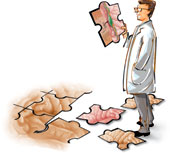 |
At first sight, pony-tailed Ryan Remedios easily passes off as a member of a local music band. This exuberant boy from Bandra in Mumbai does love music, particularly the rock and heavy metal kind, but his claim to fame comes from an altogether different field — the “brainy” world of science.
Ryan may still be in his twenties, but his accomplishments could make the foremost researchers in Indian science green with envy. His papers, published in top-of-the-line journals, bear testimony to his talent. Currently pursuing his PhD at the Max Plank Institute for Biological Cybernetics in Tübingen, Germany, he is also the first author of an Indian study whose work appears in the journal Nature Neuroscience (September 2007).
The study, that commenced shortly after he joined Mumbai’s Tata Institute of Fundamental Research (TIFR) after an undergraduate degree from a local college in 2002, explores a tiny, almond-shaped area in the brain called the amygdala. This region plays a role in processing and remembering emotional reactions. The work, initiated by him as a student at Shubha Tole’s lab in the department of biological sciences at TIFR, has resolved the mystery of how neurons learn to form layers.
“The initial spark for this work came from Ryan,” says Dr Tole, Ryan’s guide, who spotted his innate talent and patiently nurtured it over the three years that he spent at TIFR. “Ryan wasn’t a top-of-the-class student. The conventional mode of exams failed to spot the genius in him,” she observes. Dr Tole passionately recollects how Ryan used to spend long hours, with endless rounds of tea thrown in, in the institute’s sea-facing West canteen, explaining his ideas to her and other colleagues.
 |
| Ryan Remedios |
Ryan struck gold very early when he discovered the genes involved in the development of a poorly understood part of the amygdala. The finding was so significant that it made its way to the reputed Journal of Neuroscience, a terrific feat for a first-timer. That was in 2004.
Ryan’s continued focus on this tiny spot in the amygdala made him notice something very puzzling: a migration of a stream of neurons in the region. This “aberration” was baffling because it was earlier thought that the amygdala neurons in a developing brain moved to their pre-determined positions using simple mechanisms. But the upward movement of neurons — taking the help of vertical “ropes” — that the TIFR scientists observed in the amygdala is normally associated with the cerebral cortex, the most complex brain structure involved in almost all higher functions we are capable of such as problem solving, thinking, memory and attention.
The amygdala, on the other hand, is evolutionarily a primitive structure and does not, unlike the cortex, have a layered structure. And it is found not only in mammals but also in birds, reptiles and amphibians.
 |
| Dr Shubha Tole |
This chance discovery set Dr Tole and the others thinking. If such migration of neurons was happening in the amygdala, it meant the highly evolved layer formation found in the cortex of humans and other mammals would have had a primitive origin, they thought.
The human cortex has as many as six layers with layer 4 being responsible for receiving sensory stimuli from primary organs such as the eyes and ears. Subsequently, the signals are passed on to other layers in the cortex for further processing and eventual action.
Over 100 billion neurons are packed in the human brain with more than a thousand ways of connecting them. Understanding how the brain is assembled is important for understanding its function, says Dr Tole. Comprehending the layer formation by neurons is important because everything that happens in the cortex depends on that.
There are different types of neurons in the brain. Similar types of these cells, thus formed, move upward — quite like snakes climbing ropes — and form a layer of cortex. Neurons of a different type then must climb over the first layer to form the second layer. This goes on until six layers are formed, each containing a particular type of neuron. And this must occur with precision, because the consequences of something going wrong are disastrous.
If there is any trouble — either the ropes aren’t alright, or the neurons can’t hold onto them easily — the layering of the brain gets severely affected, Dr Tole observes. This would cause serious problems for brain function, since neurons in one layer perform different functions from those in another. Any mistake will result in a messed up wiring pattern in the brain, resulting in disorders such as mental retardation, autism and schizophrenia.
This six-layered cerebral cortex is found only in mammals and is hugely expanded in humans. Humans are capable of complex brain functions because the cortex is highly evolved and refined, with different sets of neurons carrying out different sets of jobs. This was made possible because the neurons there have somehow figured out how to climb up into well-ordered layers.
How is this intricate organisation of neurons in the cortex created in the embryo while it is still growing in the womb? The TIFR scientists thought the answer could come from analysing how and why neurons migrate in this part of the amygdala which was distinctly different from the rest of the structure. Using pregnant Swiss mice, they studied the formation of neuron streams in the amygdala. The surprising finding made them infer that it was in the amygdala that neurons learned the rope-climbing technique.
Gundela Meyer, professor of anatomy at the University of La Laguna in Spain, thinks that understanding how the layer formation of neurons came into being and how it moved up in the evolutionary chain is of extreme importance. “The TIFR scientists have made a beginning by spotting this in the amygdala,” she told KnowHow.
“This work offers the first insight into the evolutionary beginnings of the cerebral cortex,” says Dr Tole.
Sumanta Chatterjee of the National Centre for Biological Sciences in Bangalore, too, is quite impressed. The amygdala, responsible the “fight-or-flight” reflex of organisms, is least understood. “The work by Tole and others is sure to open up new avenues of research that could throw light on some of the complex brain functioning,” he says.
Ryan, however, has moved on. In Tübingen, he is trying to figure out the mysteries of yet another little-understood brain structure called the claustrum. This thin, irregular and “sheet-like” structure is linked to cognitive function. “The claustrum is even more of an enigma than the amygdala is,” says Ryan.











